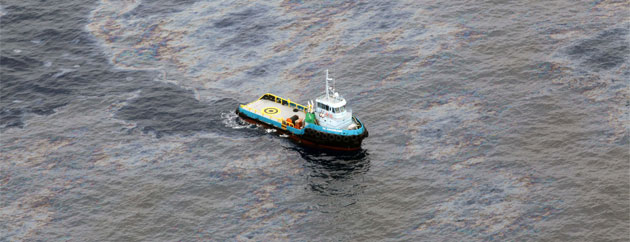
Chevron in open conflict With Brazil and Ecuador over worsening oil spills
24 November, 2011Chevron, which already faces allegations of fraud over an $18 billion liability in Ecuador for environmental damage, is being accused in Brazil of trying to cover up the extent of an oil spill caused by one of the company’s offshore drilling rigs, leading to the company’s second major conflict with a key Latin American oil-producing nation.
Misleading statements from Chevron about the size of the November 8th spill and its containment have led several Brazilian officials and environmental groups to criticize Chevron and demand more transparency from the oil giant, said Karen Hinton, spokesperson for the Ecuadorians who successfully sued Chevron for massive oil contamination in the rainforest.
According to the environmental group Greenpeace, whose activists today spilled black ink at the door of Chevron’s Rio office, satellite pictures obtained by NASA show a spill “10 times bigger” than Chevron’s estimate of 330 barrels a day. Rio state’s Environmental Secretary Carlos Mink said, “The accident must be bigger than what is being announced. We are going to demand compensation…. The company must be punished in an exemplary manner.”
Chevron is already in open conflict with Ecuador’s government as part of its strategy to discredit the $18 billion judgment against it obtained in Ecuador’s courts by rainforest residents. For almost three decades, Chevron’s predecessor company Texaco dumped billions of gallons of toxic oil waste into the Amazon, leading to an environmental and public health catastrophe that dwarfs the extent of the BP calamity, according to evidence before the Ecuador court.
“Chevron’s oil disaster in Brazil, and apparent cover-up, once again shows that the company has a systemic problem in failing to meet its environmental obligations to the communities where it does business,” said Pablo Fajardo, the lead Ecuadorian lawyer who defeated Chevron in the 18-year legal battle.
“This type of dishonest behavior clearly puts Chevron at a competitive disadvantage relative to its peers, particularly in Latin America,” he added.
Humberto Piaguaje, an indigenous leader in the area of Ecuador where Chevron operated, said Brazil should not trust Chevron to take responsibility for its actions.
“In Ecuador, we have lived with Chevron’s contamination for five decades, and the company has refused to pay for the damage and destruction it caused. All governments in Latin America should beware of these basic facts before they do business with this company,” said Piaguaje.
Chevron’s management of its oil spills is not much better even in the United States. The oil giant recently agreed to a $4.5 million settlement with environmental officials in the state of Utah for two oil spills that polluted a creek and city pond. In that incident, Chevron also underestimated the amount of oil spilled, which contaminated a lake and impacted fish and wildlife.
In Ecuador, Chevron has tried to pressure President Rafael Correa to violate his country’s Constitution – which guarantees Separation of Powers and an independent judiciary – and reach into the courthouse in Lago Agrio to quash the lawsuit, said Fajardo.
After an eight-year trial, the Ecuador court found Chevron responsible for the systematic dumping of billions of gallons of toxic waste into the Amazon from 1964 to 1992, when Texaco operated a large oil concession with 378 wells and production stations. The dumping decimated indigenous groups and created a spike in cancer rates and other oil-related illnesses, according to evidence before the court.
The indigenous and farmer communities in the area of Ecuador where Chevron operated have accused the oil giant of fraud in trying to cover up several waste pits with dirt and engaging in a sham remediation to hide its environmental crimes, said Fajardo.
Follow Sounds and Colours: Facebook / Twitter / Instagram / Mixcloud / Soundcloud / Bandcamp
Subscribe to the Sounds and Colours Newsletter for regular updates, news and competitions bringing the best of Latin American culture direct to your Inbox.

